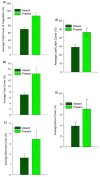The Influence of Prescribed Fire, Habitat, and Weather on Amblyomma americanum (Ixodida: Ixodidae) in West-Central Illinois, USA
- PMID: 29565805
- PMCID: PMC6023455
- DOI: 10.3390/insects9020036
The Influence of Prescribed Fire, Habitat, and Weather on Amblyomma americanum (Ixodida: Ixodidae) in West-Central Illinois, USA
Abstract
The distribution of Amblyomma americanum (L.) is changing and reports of tick-borne disease transmitted by A. americanum are increasing in the USA. We used flagging to collect ticks, surveyed vegetation and collected weather data in 2015 and 2016. A. americanum dominated collections in both years (97%). Ticks did not differ among burn treatments; however, tick abundance differed between years among total, adult, and larval ticks. Habitat variables showed a weak negative correlation to total ticks in respect to: Shannon diversity index, percent bare ground, perennial cover, and coarse woody debris. Nymphal ticks showed a weak negative correlation to percent bare ground and fewer adults were collected in areas with more leaf litter and coarse woody debris. Conversely, we found larvae more often in areas with more total cover, biennials, vines, shrubs, and leaf litter, suggesting habitat is important for this life stage. We compared weather variables to tick presence and found, in 2015, temperature, precipitation, humidity, and sample period influenced tick collection and were life stage specific. In 2016, temperature, precipitation, humidity, wind, and sample period influenced tick collection and were also life stage specific. These results indicate that spring burns in an oak woodland do not reduce ticks; other variables such as habitat and weather are more influential on tick abundance or presence at different life stages.
Keywords: litter cover; lone star tick; microclimate; oak woodland; prescribed burning; tick ecology; vegetation structure.
Conflict of interest statement
The authors declare no conflict of interest.
Figures


Similar articles
-
Micro- and Macroenvironment and Habitat Influences on Tick Abundance in Oklahoma City Urban Parks.Am J Trop Med Hyg. 2025 Apr 22;113(1):187-199. doi: 10.4269/ajtmh.24-0418. Print 2025 Jul 2. Am J Trop Med Hyg. 2025. PMID: 40262600
-
The effects of Solenopsis invicta (Hymenoptera: Formicidae) and burned habitat on the survival of Amblyomma americanum (Acari: Ixodidae) and Amblyomma maculatum (Acari: Ixodidae).J Med Entomol. 2013 Mar;50(2):270-6. doi: 10.1603/me12168. J Med Entomol. 2013. PMID: 23540113
-
Mapping the distribution of Amblyomma americanum in Georgia, USA.Parasit Vectors. 2024 Feb 11;17(1):62. doi: 10.1186/s13071-024-06142-7. Parasit Vectors. 2024. PMID: 38342907 Free PMC article.
-
Role of the lone star tick, Amblyomma americanum (L.), in human and animal diseases.Vet Parasitol. 2009 Mar 9;160(1-2):1-12. doi: 10.1016/j.vetpar.2008.10.089. Epub 2008 Oct 28. Vet Parasitol. 2009. PMID: 19054615 Review.
-
The expanding spectrum of disease caused by the Lone Star Tick, Amblyomma americanum.Infez Med. 2021 Sep 10;29(3):378-385. doi: 10.53854/liim-2903-8. eCollection 2021. Infez Med. 2021. PMID: 35146342 Free PMC article. Review.
Cited by
-
Predicting the potential distribution of Amblyomma americanum (Acari: Ixodidae) infestation in New Zealand, using maximum entropy-based ecological niche modelling.Exp Appl Acarol. 2020 Feb;80(2):227-245. doi: 10.1007/s10493-019-00460-7. Epub 2020 Jan 21. Exp Appl Acarol. 2020. PMID: 31965414 Free PMC article.
-
Modeling the differential effect of prescribed fire on multi-vector tick-borne tularemia disease.PLoS One. 2025 Aug 11;20(8):e0329465. doi: 10.1371/journal.pone.0329465. eCollection 2025. PLoS One. 2025. PMID: 40788927 Free PMC article.
-
An analysis of companion animal tick encounters as revealed by photograph-based crowdsourced data.Vet Med Sci. 2021 Nov;7(6):2198-2208. doi: 10.1002/vms3.586. Epub 2021 Aug 20. Vet Med Sci. 2021. PMID: 34414695 Free PMC article.
-
Assessing the Influence of Climate Change and Environmental Factors on the Top Tick-Borne Diseases in the United States: A Systematic Review.Microorganisms. 2023 Dec 27;12(1):50. doi: 10.3390/microorganisms12010050. Microorganisms. 2023. PMID: 38257877 Free PMC article. Review.
-
Impact of Unexplored Data Sources on the Historical Distribution of Three Vector Tick Species in Illinois.J Med Entomol. 2020 May 4;57(3):872-883. doi: 10.1093/jme/tjz235. J Med Entomol. 2020. PMID: 31832656 Free PMC article.
References
LinkOut - more resources
Full Text Sources
Other Literature Sources

